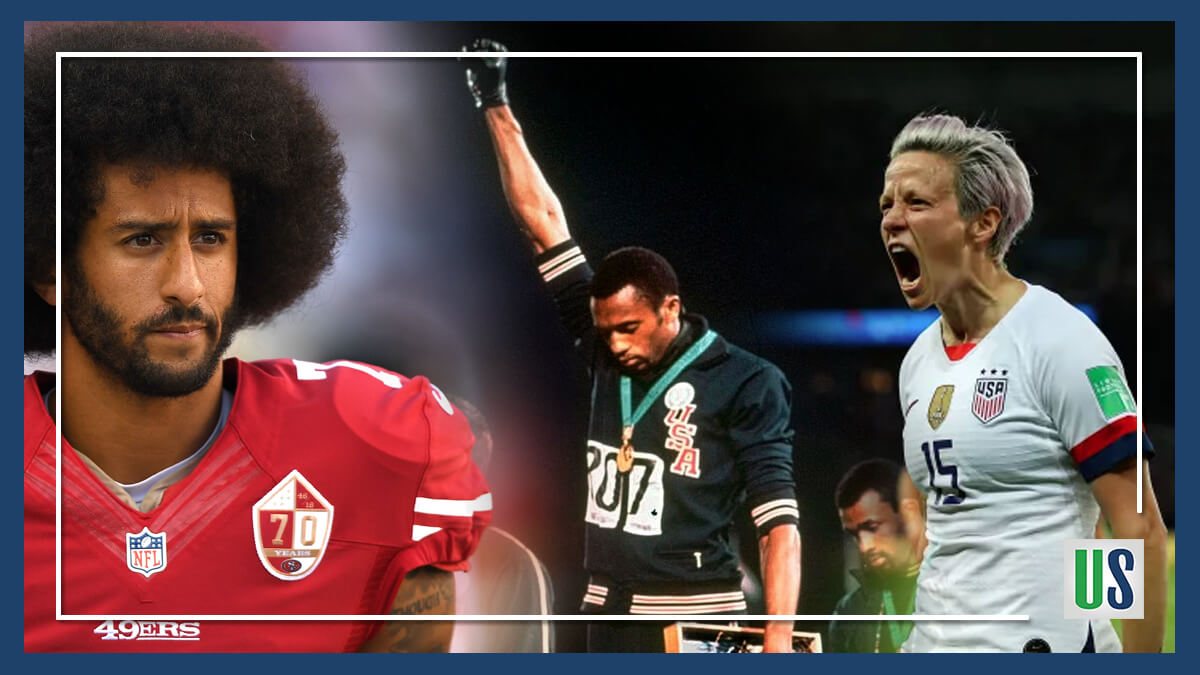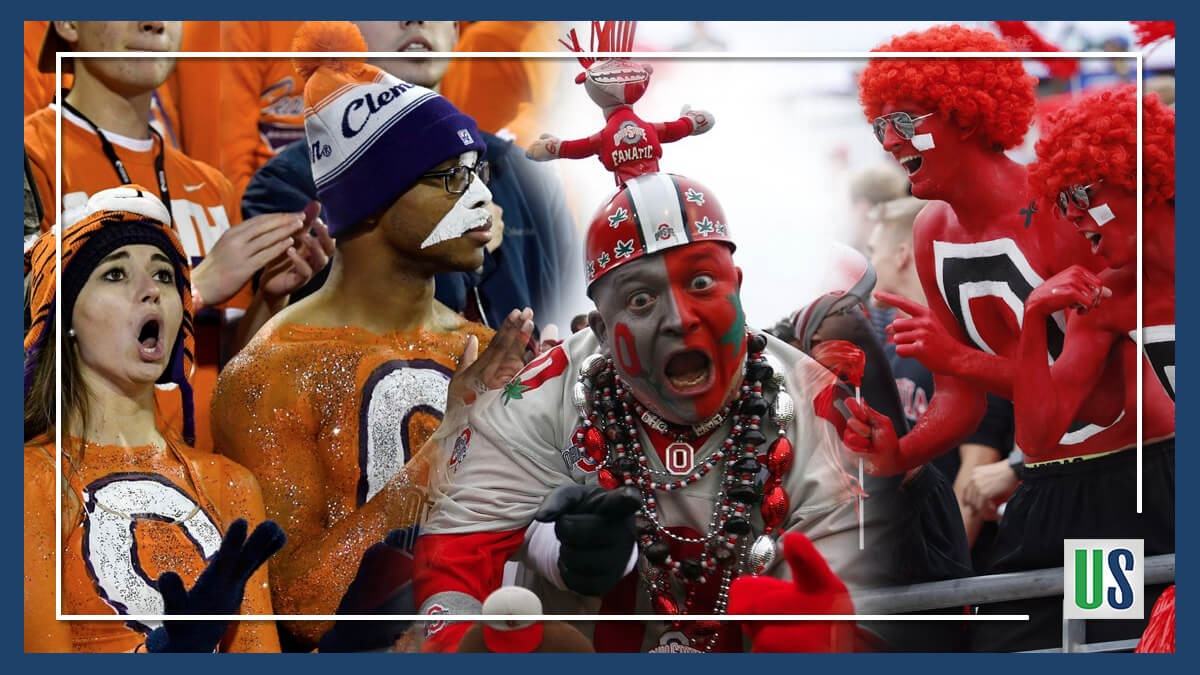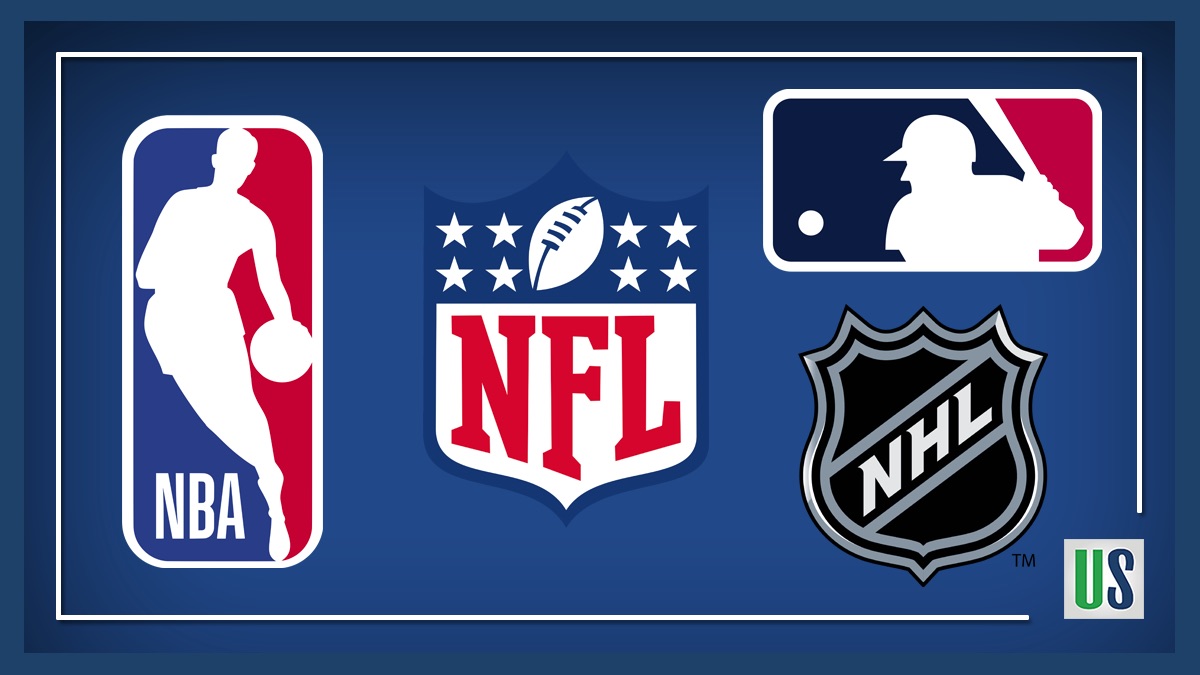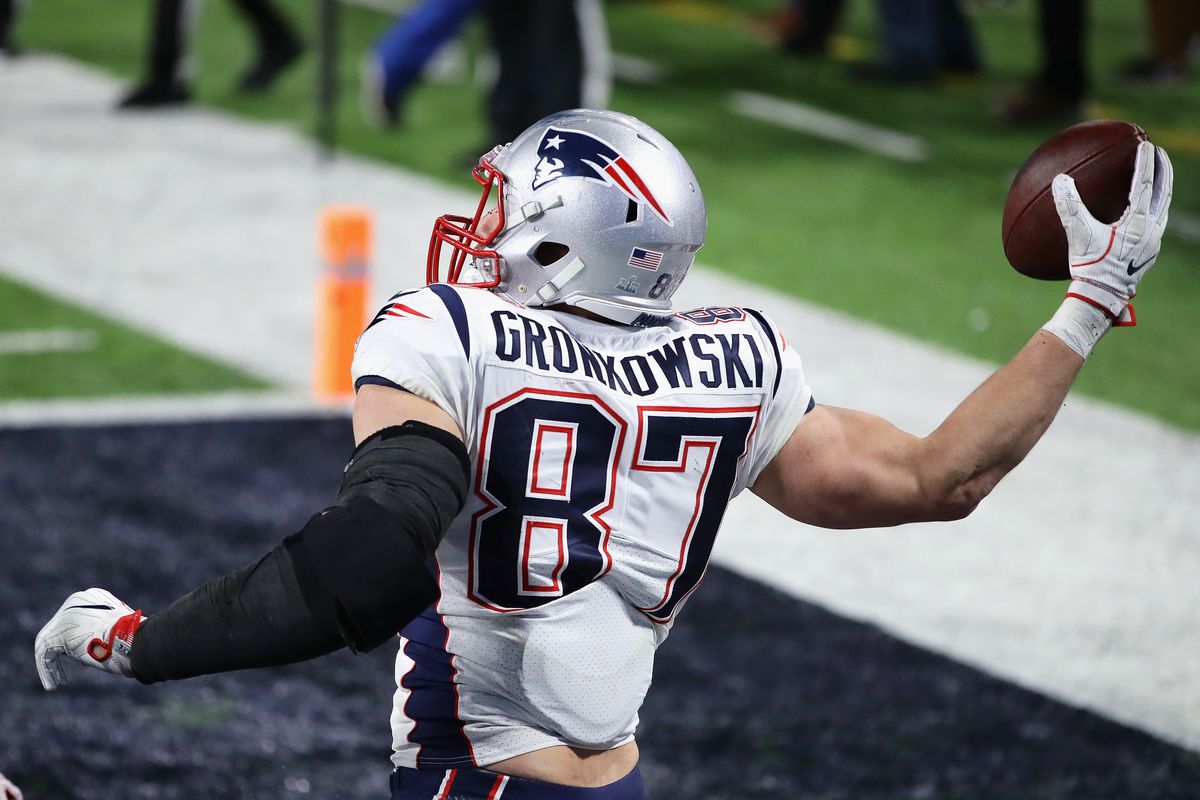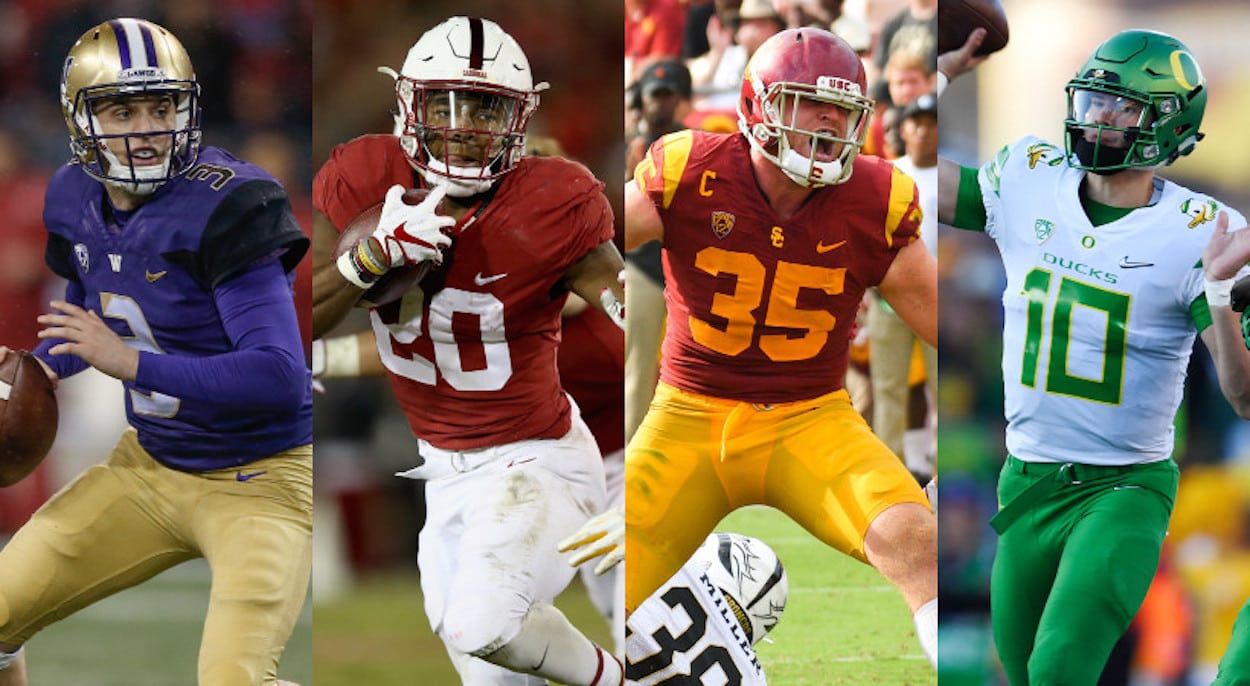Sports and politics dominate our attention. Often the two combine despite many athletes being told to ‘stick to sports’. That’s a good thing.
Continue readingYour Brain on Football: Physical and Psychological Effects of Sports Fandom
A year ago, I wrote a post about how and why absurdly addicted I, and most of the world, am to sports. Here are the physical and psychological effects of sports fandom, with a few updates…
Football Fandom Runs Deep and Affects the Brain
My Texas A&M football fandom began at a young age, and it’s progressively worsened into a serious condition. Symptoms include irrational beliefs that “this season will be different” (every season); uncontrollable emotion anytime my team scores, recovers a fumble, or intercepts a pass; low-key stalking high school players to learn where they’ll commit; and owning enough maroon clothing to outfit a small village.
Though my addiction might seem absurd to some, I know I’m in good company. Across the globe, sports enthusiasts do seemingly crazy things in the name of fandom every day. It’s as if our critical thinking skills are hindered by an addiction to our team.
And, that’s it. We’re addicts- looking for our next high. We sacrifice reason and logic for a chance to feel that flood of dopamine when A&M beats Clemson (hey, it could happen; we’re only 11 point underdogs).*
*Update: remember how I said it could happen? Well it basically did, but it’s part of the tragic hero nature of Aggie football to get screwed by refs:
Your Sports Addiction is Scientific: Physical and Psychological Effects are Real
There’s science to support the potentially addictive nature of fandom. We have very measurable physical effects when watching, or even discussing, our team. Elevated blood pressure, increased adrenaline, and changes in posture or speech are just a few of physical characteristics that accompany game time behavior.
If you listen to a die-hard sports fan, you’ll notice the abundance of the word “we.” In this, the fan is grouping himself with the players, coaches, and fellow fans. It’s our mirror neurons that give us the ability to place ourselves in the shoes of the actual players. Though we’re not in the game, we still feel like we have a part in the outcome. Our addiction is both physical and psychological.
Personally, I think this addiction to sports is both wonderful and terrible.
Humans crave connection. We’re built for community. For many, sports offer the chance to be a part of something. For me, being an Aggie is belonging to a cult community of individuals who share a passion for something bigger than any one of us. But, it’s not just an Aggie thing.
For a large portion of the world, soccer is an integral part of culture. The passion and community of soccer fans is an incredible sight to behold. For millions of children and adults, soccer isn’t just a sport, but it’s the escape from an often challenging life. Watching a game offers a momentary reprieve from the stresses of life.*
*Update: this year’s Women’s World Cup was massively controversial for Americans. Political speech from players dominated and divided the country. As a result, some Americans rooted for England to win the title…before the game began. But, fandom and patriotism took effect shortly after the first kick, and by the end, most Americans were proud to once again beat the British.
Athletes and Coaches Can Do No Wrong
The dark side of fandom is our ability to rationalize away sins for the players, coaches, and schools we love. I’m going to call out Ohio State University here because it’s the most recent, most egregious example of ignoring blatant misconduct for the sake of winning. When we let our addiction to the game supersede our morality, we set a dangerous precedent. Sure, Urban Meyer is a phenomenal coach, but he’s also a jerk. And, what are we saying to the up and coming generation about accountability when we let Coach Meyer off the hook because he wins games? I don’t think these are the values we should be teaching. Our addiction has clouded our judgement.
OSU isn’t the only administration to permit poor conduct. Every fan base has moments in its history we’d like to hide. We’ve all justified bad behavior from our favorite players and swore, “he’s really not a bad guy… he just made a mistake.”
From the outsider’s perspective, the amount of energy and emotion we dedicate to teams and players almost seems like lunacy. It’s just a game, right? They may just be games, but for many, they’re also community. They’re part of our identity. We feel successful when our team wins- a sense of failure when they lose. When our coach receives criticism for misconduct, we feel personally attacked.
For me, the addiction is well worth it. I’ve made some of my best friends at those games. I’ve cried tears of joy and frustration at those games (if you’re an Aggie and didn’t cry when we beat Alabama in 2012 and when we lost to UCLA in 2017, you’re a monster). The community and connection I find as a fan is unbeatable… even though my team is usually very beatable.
I have no doubt I will continue to do ridiculous things in the name of fandom; and I know I’m surrounded by good people who’ll be doing the same.*
*Update: this is a personal note, but the last few dates I had were with guys who didn’t know or enjoy football. As a football addict, I wondered if this meant my life would be spent pining for an Aggie natty alone. But this article’s posting last year convinced another Ag that there are women who might be as obsessed about recruiting as he is. And I hear wedding bells set to the tune of the Aggie War Hymn.
2019 College Football is Almost Here
Here’s to another season of turbulence- high highs and low lows. God bless Jimbo Fisher, Aggie football, and the community we sports fans need to survive the physical and psychological effects of sports.
Will the NBA, MLB or NHL Overtake the NFL As America’s Favorite Sport?
America Loves Football
Football. It’s Goliath and America’s favorite sport. Since the
In order to find out, this article will review America’s Big-Three:
- The National Football League (NFL)
- Major League Baseball (MLB)
- The National Basketball Association (NBA)
This article will also discuss the rise of the National Hockey League (NHL) and Major League Soccer (MLS).
Major League Baseball (MLB)
Although baseball is no longer America’s Pastime, it has still done very well in recent years. Major League Baseball has seen 16 consecutive years of gross revenue records. “Since 1992, when Bud Selig took over as commissioner on a full-time basis, league gross revenues have grown 377% when accounting for inflation.” In 2018, Major League Baseball totaled 10.3 billion dollars in revenue. Baseball got paid. Even with a four-percent drop in attendance in 2018, its television revenues remained stable while sponsorship increased. In addition, Fox signed a new extension with Major League Baseball that runs from 2022 to 2028 and totals 5.1 billion dollars.
The problem with baseball’s overall popularity is it’s singular nature. Most baseball fans couldn’t care less about any league other than Major League Baseball. College baseball, Triple-A baseball have limited fandom attached. NCAA football and basketball are huge. Soccer has a plethora of different sports leagues spanning the entire globe in addition to the World Cup for both women and men. Basketball also has the NCAA tournament for women and the Women’s National Basketball Association (WNBA). Baseball doesn’t have that. It is an isolated sports league in revenue, views and fans. So it makes sense that many American’s don’t choose baseball as their favorite sport.
However, as far as fans per league go, baseball is still mainstream. As of 2017 data, Major League Baseball, when compared to other American professional sports, had:
- Highest attendance
- Second-most active fans
- Second-most Avid fans
- Second-most fans of any interest
- Second-most television views
- Second-most purchased clothing/apparel with team logos
Will Major League Baseball outgrow the National Football League? It’s highly unlikely. Nonetheless, Major League Baseball revenue, attendance, and television viewership will keep it relevant for years to come.
The National Basketball Association (NBA)
Basketball is attempting to make a major push as a contender. In an interview with CNBC, Washington Wizards majority-owner Ted Leonis compared the NBA to a growing stock. High speed cameras, data, and transparency have set up the NBA for gaming and gambling. Considering the supreme court recently declared sports gambling legal, this is an incredibly smart move by the NBA. The Wizards even broadcasted games on an alternate local channel that was designed for sports gamblers. Including real-time odds and contests may seem insignificant, but attracting a new and growing sports gambling market will set the NBA up quite nicely.
One argument against the growth of basketball is the ratings of the 2017-2018 NBA Finals. Just a few years prior, the 2015-2016 NBA Finals had the best ratings since Michael Jordan and the Chicago Bulls had their second three-peat. The 31 million viewers put Game Seven of the 2015-2016 NBA Finals in elite company. Only two other NBA Finals games, both in different three-peat Championship games of Michael Jordan and the Chicago Bulls, had over 30 million viewers. But in the 2017-2018 NBA Finals, the average viewers dropped nearly 3 million from the previous season.
Perhaps this is due to fans seeing LeBron James and the Cleveland Cavaliers battle Stephen Curry and the Golden State Warriors for the fourth-consecutive season. Fans were bored. It was the same story each year. LeBron dragging a team to the NBA Finals only to lose to the Golden State Warriors wasn’t anything new. But lucky for the NBA, this will be the first post-season without LeBron James since the 2004-2005 season. The 2018-2019 NBA Finals will also be the first LeBron-less finals in nine seasons. This season is different and the parity will be refreshing for basketball followers.
NBA Global Expansion
Ratings aside, the NBA is evolving and pushing worldwide expansion. Striking international broadcast deals and making games/highlights more viewable for international audiences is the NBA’s newest target. The top-five markets for NBA basketball outside the US are China, Austrailia, Brazil, Canada and Mexico. There are currently over 178 million Chinese followers of the NBA across social media channels in addition to over 300 million Chinese basketball players. More than 30-percent of the NBA league pass subscriptions are in Asia. Basketball is also the second-fastest growing sport in India and the league in running Junior NBA schemes across Asia and Australia.
This global expansion is welcomed and operated by owners and players alike. Ted Leonis described international games as business trips. Winning the game was only one part of the goal for players and management. Public appearances, sponsorship meetings and media deals were just as important to the league. Making NBA basketball global has a huge monetary incentive. Creating a larger market allows for a greater chance for sponsors, media deals and merchandise sales. It also increases the likelihood of talent. India and China alone combine for nearly 2.8 billion people. They make up 36-percent of the world’s population. Capitalizing on that market is the NBA’s best chance to compete with the NFL.
The NBA is a strong contender for 2030’s top American sports league. If they continue to press these three goals:
- Capture Sports Gambling Market with Gambling-Friendly Broadcasts
- Increase Talent Pool Worldwide
- Grow International Revenue and Media Deals
The National Hockey League (NHL)
With the expansion to Seattle in 2021, the National Hockey League will have its 32nd franchise, equaling the NFL’s total. Hockey has been growing in the US and making its way across the states. This can be seen by its revenue jump in the past decade. Since the 2006-2007 season, the NHL’s revenue has doubled. Gathering in over 4 billion dollars in revenue in 2017-2018 pushed the NHL to become the fifth-highest sports league in the world in revenue. Expansion to more cities and national growth of fans has been great to the NHL.
Of note, hockey has also seem a substantial increase in youth popularity. While the percentage of 6-12 year olds playing youth football, basketball, baseball, and soccer has declined, youth hockey has seen a 64-percent rise in recent years. There are also roughly 45 thousand high school participants in ice hockey.
From the fans that have been paying attention, it’s no surprise that hockey is on the up and up. However, the idea the NHL will surpass the NFL by 2030 is short of a dream. The NFL brought in roughly three times the amount of revenue. With that being said, the NHL putting itself in the Big-Three by 2030 and edging out Major League Baseball does have a small chance.
Major League Soccer (MLS)
The dark horse of all American sports leagues is Major League Soccer (MLS). Many consider Major League Soccer the little brother (or distant relative) of European soccer. Yes, the Premier League does garner much success, ranking fourth in revenue in worldwide sports league. Yes the MLS has been in the shadow of other professional sports, but it has seen a hockey-like surge. Since 2008, Major League Soccer went from 14 teams to 24 and will have 27 teams by 2021. The league will also name its 28th team next season. Soccer is expanding across cities in the US.
Major League Soccer was also Yahoo Finance’s Business of the Year. Both ticket revenue and attendance were up in the 2018. Global stars like Zlatan Ibrahimovic entering Major League Soccer have drawn support and increased followers of the league.
Most important, Major League Soccer’s 30th anniversary will coincide with the 2026 FIFA World Cup. This World Cup will take place in America. Due to a joint bid for the 2026 FIFA World Cup, games will be played in Mexico, Canada and the United States. In addition, the quarterfinals through the final will all be played in the United States. This will be monumental for Major League Soccer. Hosting the world’s most popular single-sport competition will certainly give Major League Soccer a major boost.
Nevertheless, just like the NHL, Major League Soccer will not be able to compete with the NFL. If it can grow to the revenue currently experienced by the NHL, that would be a large success. But don’t set expectations high for MLS soccer.
The National Football League: The King Stay the King
Following 2017, many thought that the NFL was losing its grip on America. It experienced a drop in ratings in back to back years. But that didn’t last long. TV viewership in 2018 had resurged five-percent from 2017. Sunday Night Football also was the top primetime show seven years in a row. Viewers are no longer an argument against the NFL.
Views aside, its best to review money. If money talks, the NFL is shouting. In 2018, the NFL brought in 13.68 billion dollars in revenue, averaging 427 million dollars per franchise. The 2018 purchase of the Carolina Panthers should also be noted. David Pepper’s 2.2 billion dollar purchase was an 800 million dollar increase from the price paid for the Buffalo Bills in 2014. This revenue increase and demand is associated with commissioner Roger Goodell.
Since taking over as league commissioner in 2005, Goodell has led a revenue increase from 6.5 billion to 13.68 billion dollars. He aims for 25 billion dollars by 2027. Changing league rules, negotiating media contracts and expanding global reach to London and Mexico keeps the NFL at the top.
The introduction of the Alliance of American Football (AAF) and the reintroduction of the XFL will also raise football’s fandom. These leagues will make games more affordable to attend as a gateway to NFL game attendance. They also will act as development leagues for players, schemes, coaches, rules and business. Utilizing them in such a way will provide the NFL exactly what it needs to remain king.
Final Rankings for 2030
As much as some would love the NFL’s top spot to be taken over by 2030, it just won’t happen. Football has a firm grasp on America. Fantasy football was large enough to support “The League” for seven seasons on FX. The Super Bowl is America’s most-watched game. And roughly a third of Americans polled by Gallup picked football as their favorite sport. Football just has too much. Roger Goodell has also proved that he is willing to alter the game each season and push revenue forward for league owners. Ever evolving and popular, the NFL will still be at the top.
With that being said, the NBA will close the gap significantly with the NFL by 2030. International expansion, rising young stars and LeBron’s development with the Los Angeles Lakers will bring the NBA to sports royalty. Two giants competing with one another. Football and basketball will be the Big-Two.
In conclusion, here are my 2030 rankings for America’s sports leagues by revenue with one bold prediction for hockey:
- Big-Two: The NFL (No.1) and the NBA (No. 2)
- Next Up: The NHL (No. 3) and the MLB (No. 4)
- Keep Climbing: The MLS (No. 5)
NBA rises to meet NFL.
MLB falls below the rising NHL.
Soccer still has ground to cover.
Ten Stats That Prove Rob Gronkowski is the Greatest Tight End of All-Time
Rob Gronkowski: Greatest Tight End to Ever Play
On March 24th, 2019, following another Super Bowl-winning season, Rob Gronkowski finally decided to call it quits. Through nine NFL seasons, Gronkowski has been the most dominant tight end in the league. Whether blocking or running routes, Gronk has been the best. Now that he is officially retired, it is time to review his status as the GOAT (Greatest of All Time) tight end and Hall of Fame player with these ten stats.

The Gronk Stats
Gronk-Stat No. 1: 133.52
Since 2000, Rob Gronkowski has the highest recorded Total NEP (Net Expected Points recorded by numberFire) for a tight end season. His 2011 season was unworldly. In fact, Gronkowski has four of the thirteen highest totals at the position since 2000. As a receiving weapon, Gronk was a major contributor for his team. His ceiling and dominance as a player was unmatched.
Stat No. 2: 535.89
When we compare Rob Gronkowski to other pinnacle NFL tight ends like Tony Gonzalez, Antonio Gates and Jimmy Graham, Gronkowski’s efficiency stands out even more. Compile each of their top-five seasons in Total NEP and you get a chart that looks like this:
| Seasons | Games | Total NEP | NEP per Game | |
|---|---|---|---|---|
| Rob Gronkowski | 2011, 2012, 2014, 2015, 2017 | 71 | 535.89 | 7.55 |
| Antonio Gates | 2004, 2005, 2006, 2009, 2014 | 78 | 511.29 | 6.55 |
| Tony Gonzalez | 2000, 2004, 2008, 2009, 2012 | 80 | 514.7 | 6.43 |
| Jimmy Graham | 2011, 2012, 2013, 2014, 2016 | 79 | 463.01 | 5.86 |
What is incredible is that Gronk compiled more NEP than all of the others in only 71 games. He averaged an entire point more per game than the next man up, Antonio Gates. Gates, Gonzalez and many other tight ends may have given us longevity. But Rob Gronkowski provided more for his team on a per-game basis than any other tight end. When he was on the field, he changed the game.
Stat No. 3: 88.7
Per PFF grading, Rob Gronkowski has a career run-blocking grade of 88.7. He also holds a career pass-blocking grade of 72.6. Gronkowski was “one of the few modern-day tight ends that [was] as formidable as a run-block as he [was] a receiving weapon”. At the NFL Combine, the University of Arizona product had the following measurements:
- 6-foot 6-inches
- 264 pounds
- 10 ¾-inch hands
- 34 ¼-inch arm length
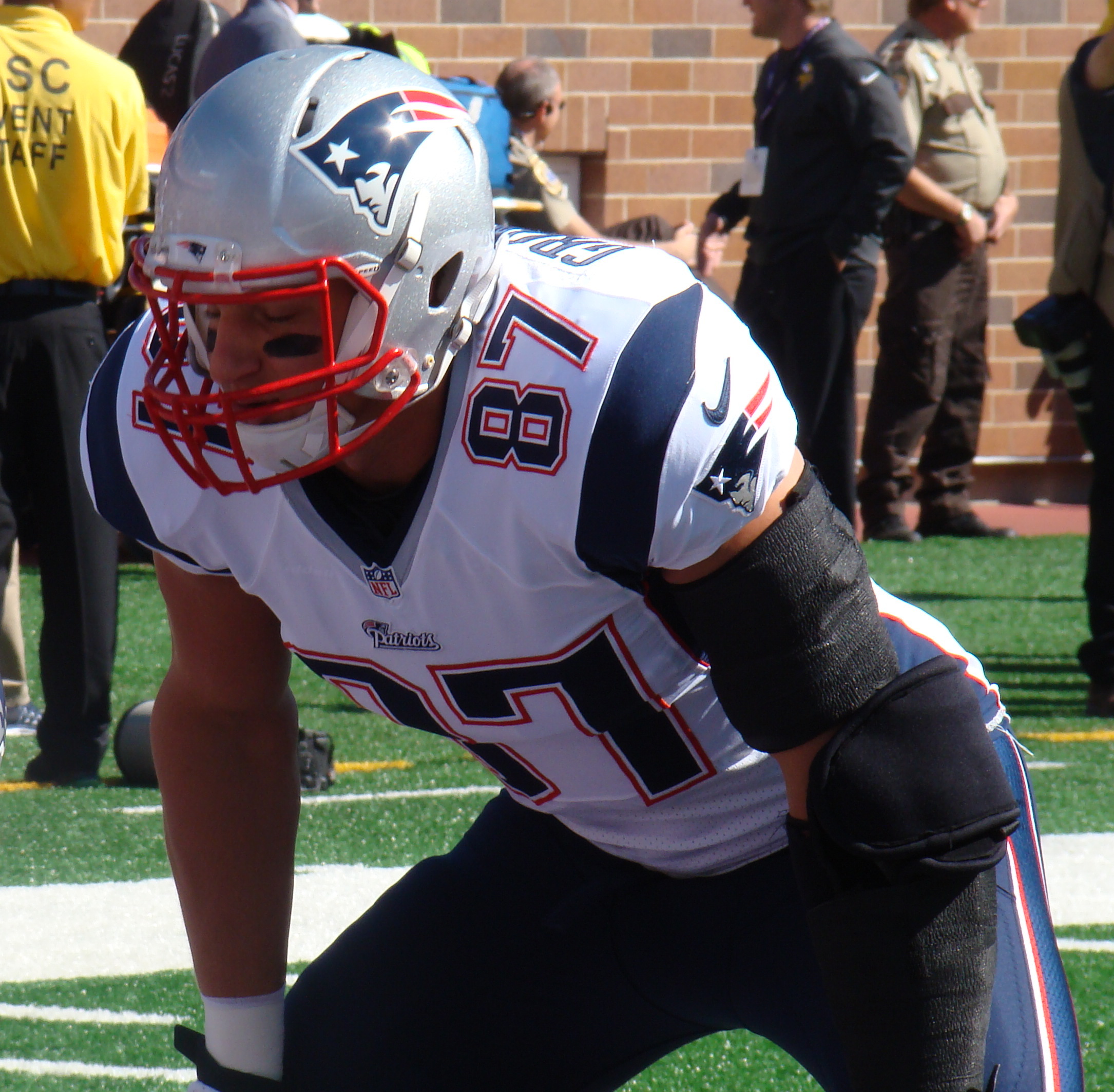
As a blocker, Gronk used every inch and pound he had. Utilizing his 88th-percentile arm length, large frame and 84th-percentile Speed Score, Rob Gronkowski was an impressive blocker. He was “a monster” on the field, according to New England Patriots’ teammate Rex Burkhead. Jason McCourty called him “a beast” and Tom Brady referred to Gronkowski as one of “the most dominant blocking tight ends in the league.”
Stat No. 4: +0.6
When it comes to scoring touchdowns, not even the Patriots could match Gronk’s prowess. When Rob Gronkowski was out of the lineup, the Patriots scored 0.6 less touchdowns per game. As Mike Clay’s numbers show, Gronkowski’s impact extended to more completions, passing yards, passing touchdowns, overall touchdowns, completion percentage and yards per attempt. All that with less pass attempts per game. Gronk made the entire Patriots offense more efficient whenever he was in the game. Of note, the 7.0 YPA would have ranked 22nd in the NFL over that time span, while 7.9 YPA would have ranked 1st. Gronkowski’s impact on an already prolific offense is unbelievable.
Stat No. 5: 5
In the NFL’s history, a tight end has recorded a ten-plus touchdown season only 38 times. Tony Gonzalez owns two of those seasons. Antonio Gates has three. Jimmy Graham notched an impressive four. However, Gronk sits atop at his position with five. Rob Gronkowski was a touchdown machine. His spikes were a regular occurrence when he was active. In fact, Gronkowski turned 10.4-percent of his targets from Tom Brady into touchdowns. Unreal.
Stat No. 6: 9.9
Rob Gronkowski retires as the all-time leader among TEs in…
— Graham Barfield (@GrahamBarfield) March 24, 2019
• Yards per game (68.3)
• TDs per game (0.69)
• Yards per target (9.9 – since 1992)
Gronk also ranks 8th-best in receptions per game (4.5) and 4th-best in YPR (15.1).
As Graham Barfield noted on Twitter, Rob Gronkowski’s efficiency was better than any other tight end in yards, touchdowns and yards per target (since 1992). While Gronk was adept at catching first downs, making diving catches or securing the football in the endzone, he was also a YAC (yards after the catch) monster. Gronkowski compiled YAC with stiff arms, broken tackles, spins or just outrunning the defense. As seen in this 79-yard catch and run, The colossal tight end made NFL secondaries look like featherweights.
Stat No. 7: 90.2
Through his nine-season career, Rob Gronkowski graced the NFL with 16 playoff games. Accumulating his PFF grades for each of those games results in a PFF grade of 90.2. Per Sam Monson at PFF, this grade would have ranked number-one overall in 2018 for tight ends. It would rank top-ten among all tight end seasons PFF has graded. Gronk already was listed on PFF’s Top 101 six separate times for his regular season performances, but in the playoffs he exceeded the highest expectations. Everyone talks about Playoff Edelman, but Playoff Gronkowski was on another level.
Stat No. 8: 330.9
In 2011, Rob Gronkowski put together the greatest single-season for a tight end. 90 receptions, 1,327 receiving yards, and 18 total touchdowns. His 330.9 PPR Points are the most ever scored by a tight end. Gronkowski’s career 15.52 PPR (Points Per Game) would also rank first all-time for tight ends.

Stat No. 9: 13.9
See you in Canton, Rob Gronkowski.
— Pro Football Focus (@PFF) March 25, 2019
A tribute, to an all-time great as told by our @PFF_Chichesterhttps://t.co/iG3tB7Vy3i pic.twitter.com/lfOCZVFNuV
As PFF’s Twitter account mentioned, Rob Gronkowski ranks higher than tight end Jason Witten, Tony Gonzalez, and Antonio Gates. Yet again, Gronkowski puts distance between himself and other tight end legends.
Stat No. 10: 129.6
When Tom Brady targeted Rob Gronkowski, he had a passer rating of 129.6. Through nine seasons, holding a passer rating that high is remarkable. Brady and Gronkowski turned 753 attempts into:
- 516 Receptions
- 7,786 yards
- 78 Touchdowns
- 13 Interceptions
Rob Gronkowski and Tom Brady were the best quarterback to receiver duo in the 21st-century.
Rob Gronkowski is a First-Ballot Hall of Famer and the GOAT Tight End
The sheer dominance that Rob Gronkowski possessed when he played football is unlike any other. With that being said, there are still doubters that Gronkowski is the greatest tight end. One argument against him is that he was plagued with injuries. However, his injuries should be an argument for his greatness. Gronkowski overcame a forearm fracture, multiple herniated discs, a torn ACL and MCL, in addition to other back, ankle, thigh, knee, hamstring, hip and lung injuries. If he didn’t have those injuries, Gronkowski would have made his 2011 season a regular occurrence. Nevertheless, he still managed to create an NFL resume that is the best of all time for tight ends.
Another criticism of Gronkowski is his shorter NFL career. Gronkowski only played nine seasons, whereas Tony Gonzalez had 17 seasons and Shannon Sharpe played for 14 years. Antonio Gates just played in his 16th season and Jason Witten will have his 16th in 2019. Admitted, Gronkowski’s career doesn’t have the longevity of others. But Barry Sanders also retired early, after just ten seasons played. That didn’t stop him from being a first ballot Hall of Famer. Neither should Gronkowski’s nine season.
Bottom line, Rob Gronkowski is without a doubt the GOAT tight end and should be an easy first-ballot Hall of Fame vote.

Blind Resumes: Who is the Most Dominant Pac-12 Team?
Who Runs the Pac-12?
College football fans love debating other college football fans about hypothetical events. Most fans rely on emotions and feelings instead of stats and facts to drive their arguments and opinions. Conversations are always heated when Pac-12 fans debate the most dominate Pac-12 team. Unafraid Show has indisputable stats to solve these debates thanks to our friend @SportsPac12. We will use the blind resumes of the four most dominant Pac-12 teams over last two decades to determine who runs the Pac-12.
If we were judging, historically USC will always win this debate because they had such a headstart on everyone else in the conference except UCLA. So, we will focus on recent history to determine who runs the Pac-12. Anybody can have an outlier season and win a conference championship, but it is extremely difficult to maintain success longterm. Take an objective look at the blind resumes to determine who currently runs the Pac:

Leave a comment to submit your vote for the Pac-12 Most Dominant Team!
Can you name the teams without google help?
No matter who your favorite team is, the future is extremely bright for the Pac-12 conference. The conference has the best coaching it has ever had from top to bottom. There are multiple national championships in store for the conference over the next decade.
Check out the Pac-12 preseason rankings and predictions for who is the most dominant Pac-12 team and who will win the conference.
Team A: Stanford Team B: USC Team C: Oregon Team D:Washington
For more thoughts on who is the most dominant Pac-12 team as well as more fresh, creative, powerful content for sports fans, check out my UnafradShow podcast.

